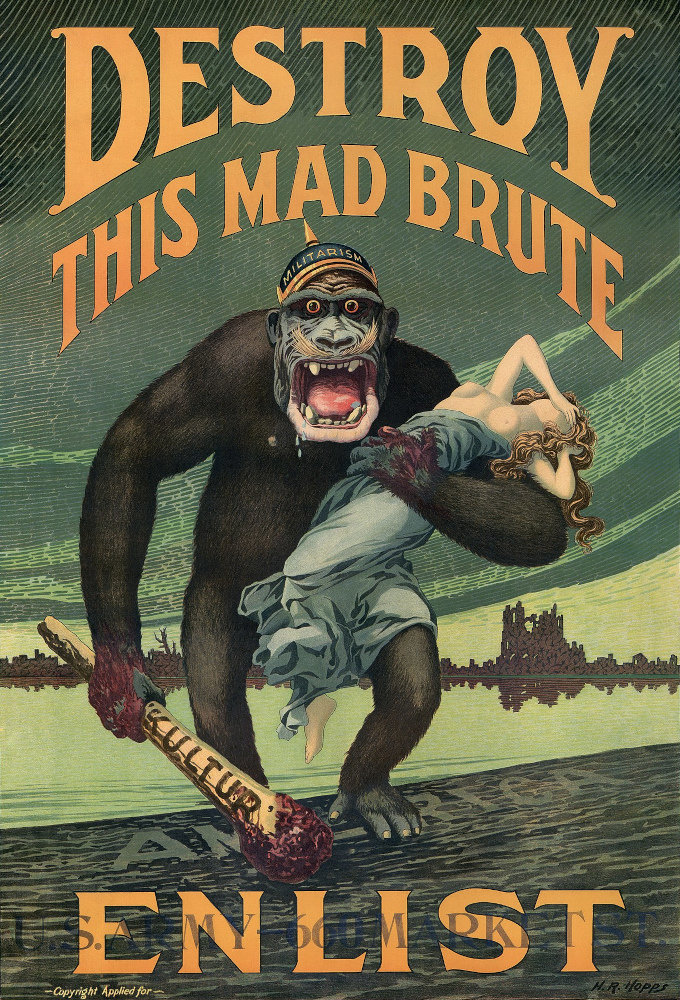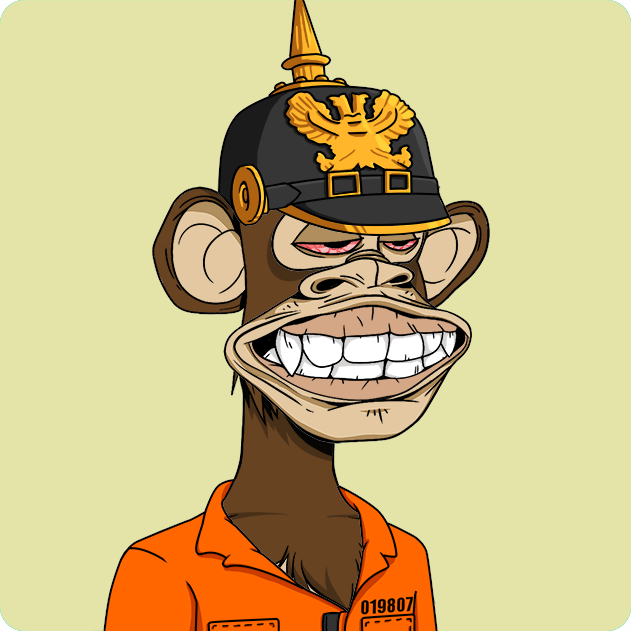Guest post by Georg Kraml
Quemadmodum, iuxta Graecorum proverbium, simia semper est simia, etiam si purpura vestiatur.
— Erasmus, Moriae Encomium
There is an essay of sorts currently making the rounds that says the people behind the Bored Ape Yacht Club are Nazis. The author is Ryder Ripps, an advertising executive, noted internet troll, and eminent NFT hustler. The essay is essentially a list of ten assorted tropes and pop culture references that Ryder says he has caught his fellow crypto marketers invoking and that he thinks are Nazi dogwhistles. [Gordon Goner; archive of 29 January]
The essay is also not very good.
About half of Ryder’s ten points are weak in the sense that nobody sober would consider them robust evidence of Nazism, although they are at least marginally tenable in the sense that the Bored Apes may have actually meant to be referencing something. The other half are just silly. There is an eleventh point, apparently added as an update, in which Ryder pats himself on the back because 4chan finds his post delightful, which he thinks means they are ‘acknowledging’ he is right. There is also a postscript of sorts in which Ryder points out that he has ‘many credentials’ — he means art projects and marketing jobs — and is at pains to emphasize that he has ‘dedicated a lot of time to researching this’, which is the sort of move I believe the kids these days refer to as ‘cringe’.
A number of crypto sceptics and media scholars I follow are acutely unhappy about Ryder’s essay but seem disinclined to explain why in any sort of detail. I believe one reason for their reluctance is that they are tired of repeating the obvious.
In a world in which absolutely everything runs on four-dimensional irony jujutsu and fifth-order self-referentiality, an edgelord cultural reference in itself is prima facie evidence of nothing. In a world in which harmless normies and progressives beyond suspicion make Yes Chad memes, play with PUA jargon, and appropriate Stonetoss cartoons, you need to make an argument for why the instance you found is evidence of extremism. An accusation of extremism that is both overexcited and undercooked in this respect just reinforces the perception in many quarters that people who worry about extremism are soyjacks and out of touch. An accusation of extremism that comes in the form of a hyperventilating barrage of disjointed factoids sprinkled with demonstrable factual errors reinforces the perception that people who worry about extremism are neurotic and high on angstlust.
Convincing yourself to ignore these things on the grounds that edgelordery itself is a sign of inchoate radicalisation is sociologically illiterate. A countercultural grammar that is reliably comprehensible to superannuated squares like me or tryhard strivers like Ryder does not exist because it would be pointless; it would fail to work as an expression of the relevant kind of sophistication and therefore of belonging. The internet is not doing anything fundamentally new here, it has merely created new strategies for outflanking, to borrow Bourdieu’s expression. Late-stage capitalism, meanwhile, has created an awful lot of young people at various levels of disconnectedness with an awful lot of time and incentive to retain ‘the aesthetic and ethical modes and models of youth’, as his magnum opus goes; they are ‘a way of showing to oneself and others that one is not finite, finished, defined’. Say what you want about 4chan, the place is a great way of not performing social maturity and therefore of prolonging the illusion of an open future.
I believe another reason nobody wants to explain why Ryder’s post is unhelpful is that the essay is functionally a Gish gallop. It would take several hundreds of words to exhaustively illustrate the defects in any one of Ryder’s itemised observations. Since the essay relies on sheer mass rather than on any connecting argument, it would take a lot more words to rebut each observation than it took Ryder to state it, and since the essay does not rely on any connecting argument, you would have to rebut basically all of them. The result would inevitably look like a nerd going well actually for twenty consecutive pages. Drawing on my fine command of indifference, I will provide a partial sketch.
The general pattern
Ryder begins his essay by discussing simianisation, which is a word for what you are doing when there is a group of people you hate and you dehumanize them by likening them to simians. Ryder believes the Bored Apes are an example of this trope; he thinks they are racist caricatures ‘intended to represent Black people and Asian people’. Ryder credits this observation with having provided the impetus for his post.
The problem a nerd would have with this argument is that it is sloppy. Simianisation really is a staple of white bigotry against racialised people, but it is just as often used in contexts with no clear racial angle. As luck would have it, Ryder’s post itself features a notable example, an American propaganda poster using an ape to represent Imperial Germany.
Imperial Germans also appear as apoplectic gorillas at least one other American propaganda poster as well as in French and Australian material; Nazi Germans appear as apes in British and Russian pictures. A lot of simianisation does not directly or primarily target any particular nation or ethnicity in the first place. There is a famous British election ad that depicts British Socialists as apelike demons; there are Socialist posters with apes representing Fascists. All things considered, the overlap between simianisation and racialisation is nowhere near complete enough to support the idea that the appearance of the former invariably means a context of the latter.
The real problem is that there is no indication the Bored Apes are meant to represent any particular outgroup to begin with. If they stand for anyone at all, the fictional members of the Bored Ape Yacht Club stand for the actual members of the Bored Apes crypto fraternity. The most common and visible way the Bored Apes are used, by a comfortable margin, is as the Twitter profile pictures of their owners. Unless you are already convinced the NFT bros are Nazis and look at these cartoons through the lens of confirmation bias, they depict just anthropomorphised apes, not pithekomorphised humans.
Ryder provides links to what he says are ‘many’ other people that have made the same observation. The number of tweets behind these links is ten, which is at least one order of magnitude less than the number of tweets that claim Lindsay Ellis is racist because she said ‘squint’ that one time. Ryder also links to two Twitter searches that he says will show numerous additional examples. As of this writing, they mainly show Asian people accusing Ryder of racism because he has jumped to unwarranted conclusions about the Bored Apes sushi chef headband.
Ryder’s remaining nine dogwhistle accusations all have the same three problems as the one in the opening paragraph: the Apes bros are probably not in fact invoking the trope that Ryder accuses them of invoking; the trope does not constitute compelling evidence of Nazism even if they are; the source that Ryder cites is either inadequate or just plainly does not say what he claims it says.
That stupid skull
Ryder’s second point is that the Bored Apes logo ‘looks very similar to the Nazi Totenkopf emblem, even containing the same amount [of] teeth in the skull’. The juxtaposition Ryder provides does indeed look suggestive, only the logo Ryder says is ‘the Nazi Totenkopf emblem’ is not the Nazi Totenkopf emblem.
No particular obsession with Nazi symbolism is necessary to pick up on this. For one thing, a German designer would not have lowercased ‘Totenkopf’. For another, the lettering is an incoherent jumble of wildly different styles of blackletter, with bits of Art Nouveau and some eighties hair metal thrown in for flavour. The one style that would not have been an anachronism is mysteriously missing. Reverse image search and server-side mtimes suggest that ‘the Nazi Totenkopf emblem’ Ryder has dredged up somewhere first appeared about a decade ago and has no significant online footprint predating the essay; most relevant hits seem to lead back to social media discussions of Ryder’s post.
Another issue is that, while the skull in the Bored Apes logo does have eighteen teeth, eighteen is not a particularly unusual value for the number of teeth in a three-quarter profile of the skull of an ape. The stock image the Bored Apes bros based their logo on has eighteen teeth. So do, as of this writing, multiple other images on the first results page for ‘ape skull’. The genuine Nazi Totenkopf, meanwhile, has either sixteen, twenty, or twenty-two teeth, depending on year and medium.
As for the overall similarity between the Bored Apes logo and Ryder’s fake Totenkopf emblem, the fashionably minimalist white-on-black seal pattern with an upper and lower legend and a pair of glyphlike dividing marks on the horizontal is not exactly rare right now. I could kill some time collecting examples from Fiverr portfolios, but look what Literally Cory Doctorow just retweeted ten minutes ago:
Some random hats
Two of the alleged dogwhistles involve headgear. First, Ryder claims that the Bored Apes Rolling Stone cover ‘features an ape with a Nazi hat on, no other militia in history has worn this style [of] hat with a skull emblem’.
The primary problem here is that there is no indication the hat on the cover is meant to be a military hat. Peaked caps with white crowns are worn by naval officers, of which the United States for instance has about sixty thousand, and in some countries by marines, which in America number a bit under five hundred thousand. They are also worn by civilian mariners, however, with America being home to some twelve million registered recreational boating vessels.
The nerd problem is that, even assuming the hat is meant to be military anyway, the real-world military hats that most closely resemble it belong to the Royal Lancers, a current British army regiment, and the Queen’s Royal Lancers, a former British army regiment, although their crowns are cavalry red rather than navy white. Skull badges also appear on the hats of Prussian and Swedish hussars, although these hats are generally mirlitons rather than peaked caps prior to the 20th century. German peaked army caps with skulls as their only or at least their primary badges do not exist; neither do German peaked navy caps with any skulls at all.
Later, Ryder claims that the Bored Apes themselves wear hats that reference Nazism. The images ‘have neo-nazi ideology and war references’, he gestures broadly at everything, his specific example being ‘this Imperial German helmet’.
The helmet, alas, is Russian. No country other than Russia has ever used a double-headed eagle as the badge on a pickelhaube.
I will admit that it is theoretically possible the helmet was meant to be German, although this assumes that the graphics artist who drew it was as unwilling to do any research as Ryder is. I will also point out, however, that Ryder is cherry picking. In addition to the Russian Army pickelhaube, there is a Soviet Army ushanka and a cap that is almost certainly meant to be a Soviet Army tankoshlem. Does the source Ryder cites back up his claim that we are looking at evidence of Nazism here? No, the link is a non sequitur leading to a picture of an Imperial German war flag.
Some more random things that are random more generally
Ryder decides that Gordon Goner, the pseudonym of one of the founders of the project, must be an anagram of something. Having consulted his favourite anagram web site, Ryder then determines that the pseudonym is ‘an anagram with only one solution, Drongo Negro’, which apparently means ‘Stupid Negro’ in Australian internet slang.
The obvious problem is that Gordon Goner has at least one other two-word anagram, the somewhat inconspicuous Drone Gorgon.
The nerd problem is that anagrams, of course, can prove absolutely anything. One name that genuinely does have exactly one useful anagram, for instance, is Ryder Ripps, the anagram in question being Drippy Errs. Between the infamous Saudi swipes against Menachem Begin, and internet’s general obsession with Jewish snoots, and The Nose Knows, Ryder’s name can be construed as a dogwhistle just as easily as Gordon’s, by Ryder’s own logic.
For his next point, Ryder claims that ‘their video game as well as [their] Rolling Stone cover feature rats with gold’, which ‘is a common anti-semitic association’.
There do not appear to be any ‘rats with gold’ either in the video game or on the Rolling Stone cover. The cover features a few rodents that might or might not be rats — their tails are hairless but also very short — in the general vicinity of some bullion. Personally, I have my doubts that ‘rats with gold’ are a ‘common association’ any more than, say, pocket calculators with buck teeth are. The source that Ryder cites, incidentally, makes no such claim.
Speaking of overactive imagination, the essay claims that the Apes bros ‘went out of their way to tell The New Yorker’ that the project had officially launched ‘the day Hitler died, April 30th’.
The article in the New Yorker that Ryder cites does support this claim. As far as we can tell from the actual text, the founders told the magazine that the project ‘had officially launched April 30th’. The article does not mention Hitler and gives no indication that the founders ‘went out of their way’ to bring up the date.
It is unclear why Ryder believes that a group of Nazis would want to celebrate the death of Adolf Hitler, not currently thought to have been heroic. It may be worth noting that April 30th is the day CERN released the World Wide Web into the public domain. Given the insistence with which crypto shills try to find parallels between the development of crypto tech and the development of the internet, this would seem to be a more likely event for a bunch of NFT bros to reference.
Anyway
The list goes on, but it gets even more boring. There is, ultimately, exactly one unambiguous piece of Nazi symbolism in Bored Apes material that Ryder points out: one of the bosses in the video game flings four-pointed throwing stars, made from bananas, that look like swastikas. A substantial proportion of throwing stars resemble swastikas, both those in real life and those in angsty manchild entertainment, but the Bored Apes quadruple banana missile does look a bit on the nose.
If Ryder’s essay is inept and irresponsible from the point of view of not liking racists, does it have any redeeming qualities from the point of view of not liking crypto? Not really. The frontier teleologists and assorted other anarcho-utopians who provide the intellectual artillery support for crypto’s program of neofeudal disruption are not going to change their minds because some number of NFT hucksters turn out to be Nazis. They have previously been unimpressed by half of Tor users being Nazis, by the other half of Tor users being there for the kiddie porn, and by social media engagement engineering seriously damaging democracies on five continents, and by Facebook setting Myanmar on fire. For a committed anarcho-utopian, enabling a few Nazis here and there is an acceptable price to pay for a successful millenarian revolt against modernity and the nanny state. There is nothing you can do about this with an itemised list of bad memes you saw someone post.
It does seem pretty likely that the Ape bros are at least casually racist. For one thing, they clearly feel at home in those corners of internet edgelord culture whose syncretism includes the troll disposition that has characterised the identitarian right since at least the eighties, the performative nihilism that has come to characterise disaffected digital natives in the wake of the Great Recession, and the ironic hipster racism that somehow always stops being ironic after a while. For another, they are shilling crypto, a project of the far right since day one.
For those who need the reminder, Bitcoin was created with the stated goals of acting as a form of ‘sound money’, stripping governments of the power to set monetary policy, and putting an end to fractional reserve banking. The school of economic thought these goals represent was informed by a deep aversion to representative democracy, redistribution, and ultimately any sort of system that could create equity and justice over the objections of the rich and the sociopathic. The DAO and NFT worlds make this link explicit by venturing to cripple not just legislatures but also the forensic resolution of disputes under property and contract law: if might is supposed to make right, then obviously possession has to be ten tenths of the law, and vice versa.
There are some crypto supporters in the ‘hacktivist’ and ‘cypherpunk’ subsets of techno-utopianism who have convinced themselves that crypto is progressive and liberatory, but the majority of blockchain bros does not bother to be in denial about where they come from. An explicit anarcho-capitalist on an explicit mission of millenarian revolt against modernity and the nanny state is virtually guaranteed to have more in common with the Kiwifarms demographic than with you. There is, as David has noted somewhere, no point in distinguishing various types of casually racist shit on the Bristol stool scale of racism.
Your subscriptions keep this site going. Sign up today!






Hey, I will fully admit that this is pedantic but as a weird history nerd I just had to point this out: the claim that “no country other than Russia has ever used a double-headed eagle as the badge on a pickelhaube” is only true if we’re talking about currently extant countries, the Austro-Hungarian Empire did indeed use double-headed eagles on certain pickelhaube helmets, although this is also still pretty obviously not a Nazi symbol as the Austro-Hungarians inherited the symbol from the Holy Roman Empire and dissolved over a decade before the Nazis came to power.
Hey David, might want to add that the whole “drongo is a racial slur” claim is based on nothing. I have plenty Australian friends that use the term, it’s a perfectly affectionate insult meaning silly/dummy. And it’s just the legacy of a pretty disastrous race horse of the same name that was essentially always lost.
https://medium.com/creatures/what-the-heck-is-a-drongo-and-why-was-it-my-mothers-favorite-insult-2c9ada967773
I was explaining the word “drongo” to a Salvadoran recently. You know those humour books of Australian slang explained as if in a dictionary? El Salvador has those for the local slang too: https://sayzonte.com/guanaco-to-english-dictionary-2/